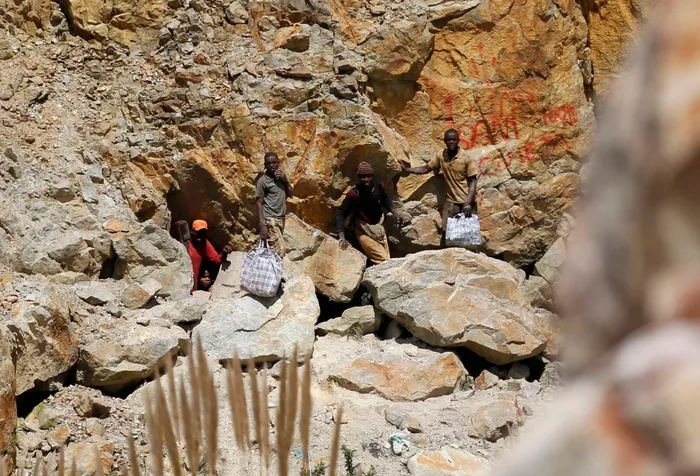Loopholes in South Africa’s mining laws allow companies to side-step accountability

File photo: REUTERS/Siphiwe Sibeko - Illegal miners leave one of the entrances to a disused mine located between the Grootvlei and the Gravelotte mines on the East Rand
By Mariette Liefferink
The South African Human Rights Commission (SAHRC) found, pursuant to its 2013 investigative hearing on the issues and challenges in relation to unregulated artisanal underground and surface mining activities in South Africa, that cessation of mining and liquidation of companies, without proper closure and remediation, contribute to illegal mining.
As was explained in an academic treatise by Professor Tracy-Lynn Field of the University of the Witwatersrand there is a disconnect between the closure requirements in the Mineral and Petroleum Resources Development Act, 28 of 2002 (MPRDA) and the process for winding up of companies in terms of Chapter 14 of the Companies Act of 1973.
The MPRDA places no specific obligation on the court to determine whether a mining right holder, applying for liquidation, has applied for a closure certificate, ensured the transfer of environmental liabilities or made adequate financial provision for its environmental liabilities.
Although the Department of Environmental Affairs proposed in its draft Regulations Pertaining to Financial Provisioning for the Rehabilitation and Remediation of Environmental Damage caused by Reconnaissance, Prospecting, Exploration, Mining or Production Operations of May 17, 2019, that the liquidator or business rescue practitioner of the company, is to be held responsible for the remediation and management of environmental impacts and the implementation of the rehabilitation- and mine-closure plans, these regulations are still awaiting implementation.
A case in point is the Mintails Group. Mintails recently came into the spotlight when eight women were raped on its abandoned North Sands Dump in Krugersdorp, allegedly by illegal miners.
Mintails Gold (Pty) Ltd, Mintails SA (Pty) Ltd and Mintails SA Randfontein Cluster (Pty) Ltd of the Mintails Group were liquidated in 2018. The group left in its wake clusters of open pits and partially reclaimed tailings storage facilities with no access controls, no management or mitigation measures; unrehabilitated footprints with potentially residual toxic and radioactive materials; toxic and radioactive dams with no fences, warning signs or access controls; contaminated wetlands; and an unfunded environmental liability of more than R460 million.
At the time of the liquidation, Mintails Limited (MLI), an Australian Securities Exchange listed company, which owned Mintails SA (MSA), divested itself from MSA by proceeding to spin off its South African subsidiary.
MLI was renamed Orminex Limited, completing what looks like a manoeuvre to avoid the liability for the environmental liabilities owed by MSA. Failure by the Department of Mineral Resources and Energy (DMRE) to enforce environmental laws, to address the gaps between mining, insolvency and company laws, and to hold the directors and shareholders of companies liable for their dereliction of duty of care, notwithstanding the recommendations of the Parliamentary Portfolio Committee on Mineral Resources, has resulted in the proliferation of illegal mining.
The DMRE and other government departments have also failed to prevent criminal and dangerous practices such as the use of mercury and the infiltration of shafts and holes not only in abandoned mine shafts but alongside operational mines.
The SAHRC found that there is a poor understanding of the profile of the unregulated artisanal miners and that not all of these individuals and groups are involved in or, if they are, began the activity with the intention of becoming involved in criminal syndicates. Not all illegal miners are non-nationals and neither are they all illegal immigrants.
The SAHRC also noted that the socioeconomic situation has pushed many people into unregulated artisanal mining. There is a direct link between the retrenchment of mine workers and unregulated artisanal mining.
The SAHRC highlighted the need for strategic research into artisanal mining; the need for a holistic, collaborative approach by all role-players – government, civil society and mining houses – to address the opportunities and challenges posed by unregulated artisanal mining; and the need for a policy and regulatory framework that focuses on the facilitation and management of artisanal mining, and not just on the criminalisation of the activities.
The DMRE is finalising its Artisanal and Small Scale Mining (ASM) Policy. The objective is to create a foundation for the formulation of a dedicated ASM legal framework and to bring artisanal miners into the mainstream economy.
The policy proposes that:
● ASM be reserved for South Africans.
● Preference to issue mining permits is given to co-operatives and not individuals.
● ASM be limited to surface and opencast mining.
● ASM coexist with large-scale mining through contributing agreements, leasing equipment, technical support and participation in the supply chain.
● The government is to train and empower ASM miners.
● The policy and legal frameworks distinguish illegal mining from ASM.
● The government is to strengthen laws to deter illegal mining and a trained detective unit to police this is also proposed.
Liefferink is the CEO of the Federation for a Sustainable Environment
Related Topics: